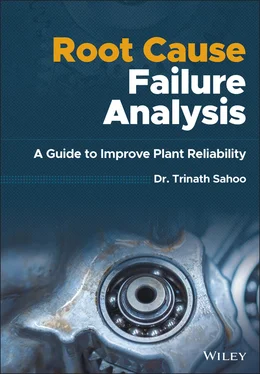Trinath Sahoo - Root Cause Failure Analysis
Здесь есть возможность читать онлайн «Trinath Sahoo - Root Cause Failure Analysis» — ознакомительный отрывок электронной книги совершенно бесплатно, а после прочтения отрывка купить полную версию. В некоторых случаях можно слушать аудио, скачать через торрент в формате fb2 и присутствует краткое содержание. Жанр: unrecognised, на английском языке. Описание произведения, (предисловие) а так же отзывы посетителей доступны на портале библиотеки ЛибКат.
- Название:Root Cause Failure Analysis
- Автор:
- Жанр:
- Год:неизвестен
- ISBN:нет данных
- Рейтинг книги:5 / 5. Голосов: 1
-
Избранное:Добавить в избранное
- Отзывы:
-
Ваша оценка:
- 100
- 1
- 2
- 3
- 4
- 5
Root Cause Failure Analysis: краткое содержание, описание и аннотация
Предлагаем к чтению аннотацию, описание, краткое содержание или предисловие (зависит от того, что написал сам автор книги «Root Cause Failure Analysis»). Если вы не нашли необходимую информацию о книге — напишите в комментариях, мы постараемся отыскать её.
Provides the knowledge and failure analysis skills necessary for preventing and investigating process equipment failures Root Cause Failure Analysis: A Guide to Improve Plant Reliability
Root Cause Failure Analysis: A Guide to Improve Plant Reliability
Root Cause Failure Analysis — читать онлайн ознакомительный отрывок
Ниже представлен текст книги, разбитый по страницам. Система сохранения места последней прочитанной страницы, позволяет с удобством читать онлайн бесплатно книгу «Root Cause Failure Analysis», без необходимости каждый раз заново искать на чём Вы остановились. Поставьте закладку, и сможете в любой момент перейти на страницу, на которой закончили чтение.
Интервал:
Закладка:
2 To arrive at the correct solution to our equipment problemsRCFA is not about addressing all the probable causes but rather failures being looked back in reverse to determine what really cause the problem. In performing RCFA, each hypothesis is verified until we have gathered enough evidence that these are the actual facts that lead to the failure itself. In completely eliminating the problem, it is important to address not only the physical cause but both the human and the latent cause.
3 Equipment failures might induce the possibility of secondary damage. Parts that are in the process of failing such as bearings will increase the vibration of equipment, this increase in vibration would be harmful to other parts that are directly coupled to the part that induce the vibration. Oftentimes secondary damage will be more costly than the parts that initially failed
4 Being proactive will give me a sense of security. Many maintenance personnel believes that a good backlog of maintenance work will ensure them of their job security. This is not the right mindset. Traditional maintenance people is confined to repairs and fixing failures but the scope of our job is beyond boundaries, our real job is to improve our equipment reliability and the scope of maintenance is beyond boundaries CBM, Oil Analysis, Lubrication, Tribology, Coaching their Operators on Basic Equipment Condition, Oil Contamination Control, Spare Parts Management, Maintenance Cost Reduction Team, just to name a few.
5 We all learn from the failure itself.
For every failure that occurred and that had been thoroughly analyzed through RCFA, there is a learning that we can all can gained from these experience in order to prevent the recurrence of the failure itself. Sometimes failures speak to us in a different language.
Root Cause Analysis in a Larger Context
The roots of RCA method can be traced to the broader field of total quality management or TQM. TQM has developed in different directions more or less simultaneously. One of these directions is the development of a number of problem analysis, problem‐solving, and improvement tools. Today, TQM possesses a large toolbox of such techniques. Further, problem‐solving is an integral part of continuous improvement. Thus, root cause analysis is one of the core building blocks in an organization’s continuous improvement efforts. However, it is important to keep in mind that root cause analysis must be made part of a larger problem‐solving effort that embraces a relentless pursuit of improvement at every level and in every department or business process of the organization.
Conclusion
Root cause analysis (RCA) is a systematic process for identifying the root causes of problems or events and an approach for responding to them. By properly carrying out RCA, problems are best solved and root causes are eliminated. However, prevention of problem recurrence by one corrective action may not always possible by merely addressing the immediate obvious symptoms. Many organizations tend to focus on single factor when trying to identify a cause, which leads to an incomplete resolution. Root cause analysis helps avoid this tendency and looks at the event as a whole. It is also important not to focus on the symptoms rather than the actual underlying problems contributing to the issue, leading to recurrence. The advantage of RCA is that it provides a structured method to identify the root cause of known problems thus ensuring a complete understanding of problems under review. By directing corrective measures at root causes, it is more probable that problem recurrence will be prevented.
3 Root Cause Analysis Process
The key to a good root cause analysis is truly understanding it. Root cause analysis (RCA) is an analysis process that helps you and your team find the root cause of an issue. RCA can be used to investigate and correct the root causes of repetitive incidents, major accidents, human errors, quality problems, equipment failures, production issues, manufacturing mistakes, and can even be used proactively to identify potential issues.
The key to successful root cause analysis is understanding a process or sequence that works. The effect is the event – what occurred. A cause is defined as a set of circumstances or conditions that allows or facilitates the existence of a condition an event. Therefore, the best strategy would be to determine why the event happened. Simply put, eliminating the cause or causes will eliminate the effect.
What is root cause analysis
Root cause analysis is a logical sequence of steps that leads the investigator through the process of isolating the facts or the contributing factor surrounding an event or failure. Once the problem has been fully defined, the analysis systematically determines the best course of action that will resolve the event and assure that it is not repeated. A contributing factor is a condition that influences the effect by increasing the probability of occurrence, hastening the effect, and increasing the seriousness of the consequences. But a contributing factor will not cause the event. For example, a lack of routine inspections prevents an operator from seeing a hydraulic line leak, which, undetected, led to a more serious failure in the hydraulic system. Lack of inspection didn’t cause the effect, but it certainly accelerated the impact.
There is a distinction between failure analysis, root cause failure analysis and root cause analisis.
Root Cause Analysis:Implies the conducting of a full‐blown analysis that identifies the Physical, Human and Latent Root Causes of HOW any undesirable event occurred. The word “Failure” has been removed to broaden the definition to include such non‐mechanical events like safety incidents, quality defects, customer complaints, administrative problems (i.e. – delayed shutdowns) and the similar events.
Failure Analysis:Stopping an analysis at the Physical Root Causes. This is typically where most people stop, what they call their “Failure Analysis”. The Physical Root is at a tangible level, usually a component level. We find that it has failed and we simply replace it. I call it a “parts changer” level because we did not learn HOW the “part failed.”
Root Cause Failure Analysis:Indicates conducting a comprehensive analysis down to all of the root causes (physical, human and latent), but connotes analysis on mechanical items only. I have found that the word “Failure” has a mechanical connotation to most people. Root Cause Analysis is applicable to much more than just mechanical situations. It is an attempt on our part to change the prevailing paradigm about Root Cause and its applicability.
RCA can be done reactively (after the failure – RCFA) or proactively (RCA). Many organizations miss opportunities to further understand when and why things go well. Was it the project team involved? The change management methodology applied during implementation? The vendor used or the equipment selected? I would argue that performing RCA on successes is just as, if not more, important for overall success than performing RCFAs on failures
The objectives for conducting a RCA are to analyze problems or events to identify:
What occurred
How it occurred
Why it occurred
Actions for averting reoccurrence that can be developed and implemented
The root cause analysis process –RCA has five identifiable steps.
1 Define the problem
2 Collect data
3 Identify possible causal factors
4 Identify the root cause
5 Recommend and implement solution
Define the problem
One of the important steps in root cause failure analysis (RCFA) is to define a problem. Effective and event descriptions are helpful to ensure the execution of appropriate root cause analyses. The first step to define the problem is by asking the four questions:
Читать дальшеИнтервал:
Закладка:
Похожие книги на «Root Cause Failure Analysis»
Представляем Вашему вниманию похожие книги на «Root Cause Failure Analysis» списком для выбора. Мы отобрали схожую по названию и смыслу литературу в надежде предоставить читателям больше вариантов отыскать новые, интересные, ещё непрочитанные произведения.
Обсуждение, отзывы о книге «Root Cause Failure Analysis» и просто собственные мнения читателей. Оставьте ваши комментарии, напишите, что Вы думаете о произведении, его смысле или главных героях. Укажите что конкретно понравилось, а что нет, и почему Вы так считаете.












